Chapter: Civil : Mechanics Of Solids : Deflection Of Beams
Evaluation of beam deflection and slope
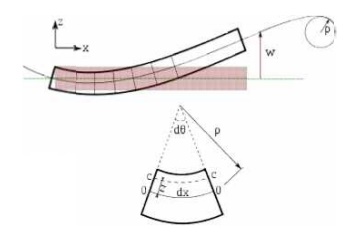
Evaluation of
beam deflection and slope
Beam deflection
Static beam equation
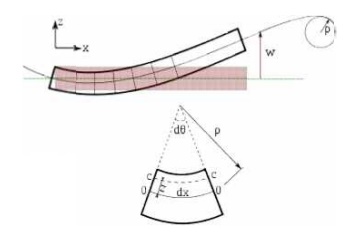
Bending
of an Euler-Bernoulli beam. Each cross-section of the beam is at 90 degrees to
the neutral axis.
The Euler-Bernoulli equation describes the
relationship between the bea m's deflection and the applied load.

The
curve w(x) describes the d eflection w of the beam at some
position x (recall that the beam is modeled as a one-dimensionall
object). q is a distributed load, in other words a force per unit length
(analogous to pressure being a force per area); it may be a funct ion of x,
w, or other variables.
Note
that E is the elastic modu lus and that I is the second moment of
area . I must be calculated with respect to the centroidal axis
perpendicular to the applied loading. F or an Euler-Bernoulli beam not under
any axial loadi ng this axis is called the neutral axis.
Often, w = w(x), q
= q(x), and EI is a constant, so that:

This equation, describing the d eflection of
a uniform, static beam, is used widely in engineering practice. Tabulated
expression s for the deflection wfor common beam configurations can be
found in engineering handbo oks. For more complicated situations the deflection
can be determined by solving the E uler-Bernoulli equation using techniques
such as the "slope deflection method", "moment distribution
method", "moment area method, "conjugate beam method",
"the principle of virtual work", "direct integration",
"Ca stigliano's method", "Macaulay's method" or the "di
rect stiffness method".
Successive derivatives of w ha ve
important meanings:
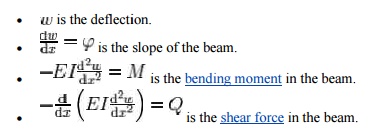
The stresses in a beam can be
calculated from the above expressions after t he deflection due to a given load
has been determined .
A number of different sign co
nventions can be found in the literature on the bending of beams and care
should be taken to maintain consistency.[6]In this article, the sign
convention has been chosen so the coordinate system is right handed. Forces
acting in the posi tive x and z directions are assumed positive.
The sign of the bending moment is chosen so that a p ositive value leads to a
tensile stress at the bottom cords. The sign of the shear force has bee n
chosen such that it matches the sign of the bending moment.
Double
integration metho d
The double integration method is a powerful tool in solving deflection and
slope of a beam at
any point because we will be a ble to get the
equation of the elastic curve.
Thus, EI / M = 1
/ y''
.
Macaulay Method
The starting point for Maucaulay's method is the
relation between bending moment and curvature from Eu ler-Bernoulli beam theory

This equation is simpler tha n the
fourth-order beam equation and can b e integrated twice to find w if the
value of M as a function of x is known. For general loadings, M
can be expressed in the form
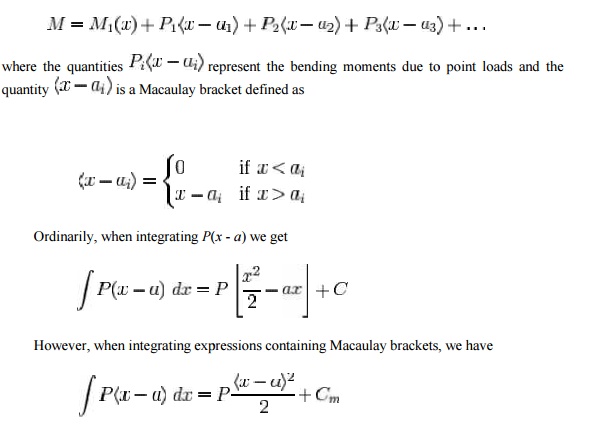
with
the difference between th e two expressions being contained in the constant Cm.
Using these integration rules makes the c alculation of the deflection of
Euler-Bernoulli beams simple in situations where there are m ultiple point
loads and point moments. Th e Macaulay method predates more sophisticated
concepts such as Dirac delta functions a nd step functions but achieves the
same outcomes for beam problems.
Example: Simply supported beam with point
load
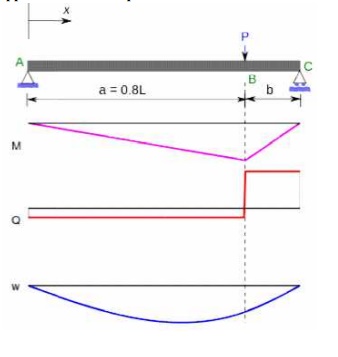
Simply supported beam with a single eccentric
concentrated load.
An illustration of the Macaulay method
considers a simply supported beam with a single eccentric concentrated load as
shown in the adjacent figure. The first step is to find M. The reactions
at the supports A and C are determined from the balance of forces and moments
as

Therefore
RA = Pb / L and the b ending moment at a point D
between A and B (0 < x < a) is given by
M =
RAx = Pbx / L
Using the moment-curvature relation and the
Euler-Bernoulli express ion for the bending moment, we have
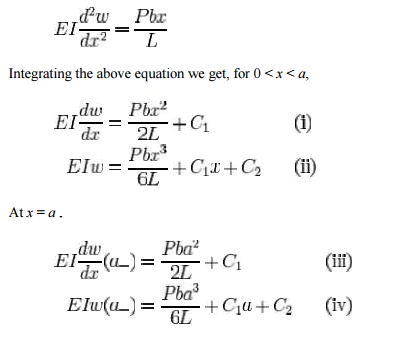
For a point D in the region
BC (a < x < L), the bending moment is
M =
RAx - P(x - a) = Pbx / L -
P(x - a)
In Macaulay's approach we us e the Macaulay
bracket form of the above ex pression to represent the fact that a point load
has been applied at location B, i.e.,
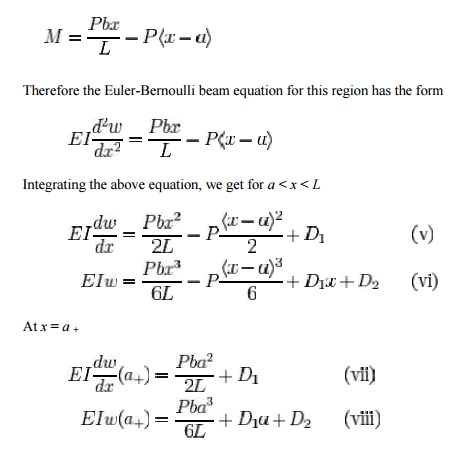
Comparing
equations (iii) & (vii) and (iv) & (viii) we notice that due to
continuity at point B, C1 = D1 and C2
= D2. The a bove observation implies that for the two regions
considered, though the equation for bending moment and hence for the curvature
are d ifferent, the constants of integration got during successive integration
of the equation for curvatur e for the two regions are the same.
The
above argument holds true for any number/type of discontinuities in the
equations for curvature, provided that in each case the equation retains the
term for the subsequent region in the form (x-a)n,(x-b)n,(x-c)n etc. It should be remembered that for any x,
giving the quantities within
the brac kets, as in the
above case, -ve
should b e neglected,
and the calculations should be
made considering only the quantities which give +ve sign for the terms within
the brackets.
Reverting back to the problem, we have

It is obvious that the first term only is to
be considered for x < a and both t he terms for x > a
and the solution is
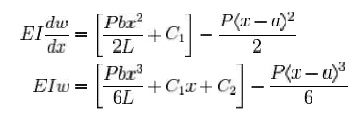
Note that the constants are placed
immediately after the first term to indicate that they go with the first term
when x < a and with both the terms when x > a.
The Macaulay brackets help as a reminder that the quantity on th e right is
zero when considering points with x < a.
Related Topics